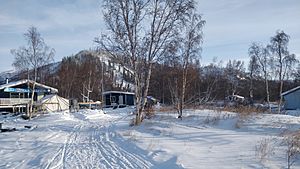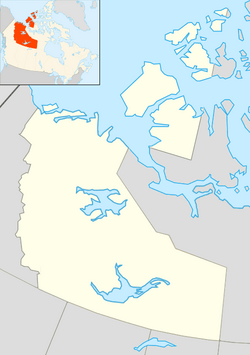Reindeer Station facts for kids
Quick facts for kids
Reindeer Station
Qunngilaaq
|
|
|---|---|
|
Locality
|
|

Modern buildings at Reindeer Station
|
|
| Country | Canada |
| Territory | Northwest Territories |
| Region | Inuvik |
| Founded | 1932 |
| Population
(1950s)
|
|
| • Total | 90 |
Reindeer Station is a place in the Northwest Territories, Canada. Its name in the Inuvialuktun language is Qunngilaaq. Today, no one lives there. It is found in the Caribou Hills, next to the eastern channel of the Mackenzie River.
The community started in 1932. It was built to keep a large group of 3,442 reindeer that the Canadian government bought. The idea was to help the local Indigenous people find a new way to live. However, not many people wanted to become reindeer herders. Because of this, the government sold the animals. Reindeer Station was then left empty in 1969. Most of its houses were moved to bigger towns like Tuktoyaktuk and Inuvik.
Contents
History of Reindeer Station
In the early 1920s, the Canadian government heard that wild caribou herds in the Western Arctic were getting smaller. This was a problem because the local Inuvialuit people relied on caribou for food. They were at risk of starving.
Something similar happened in Alaska in the 1890s. The United States government bought many reindeer from Europe. They taught Native Alaskans how to raise these animals. This program, called the Alaska Reindeer Service, was quite successful. Its main office was at the Teller Reindeer Station.
Starting the Canadian Reindeer Project
In 1926, Canada decided to try a similar program. They hired a Danish plant expert named Erling Porsild. His job was to find the best place to start a Canadian reindeer industry. By 1928, he decided the Mackenzie Delta was the best spot. Soon after, construction began on Reindeer Station.
The next year, the Canadian government made a deal. They paid $225,000 to an American "reindeer king" named Carl J. Lomen. He agreed to bring 3,000 reindeer to the Canadian Arctic. A team of Norwegian Sámi herders were hired to guide the animals.
The Long Journey of the Reindeer Herd
Government officials thought the reindeer would arrive by 1931. But the journey faced problems almost right away. In November 1929, a storm destroyed the fence where the herd was being gathered. There were also two times when the reindeer ran away in July 1931 and March 1933. These events caused big delays.
Newspapers in America and Canada often wrote about the slow journey. The Sámi leader of the group, Andrew Bahr, was even called "The Arctic Moses." By June 1934, the herd reached the ice-covered Mackenzie Delta. But another storm caused the animals to run back to the western side. The warm summer weather meant they could not try to cross again until the next year.
On March 6, 1935, the herd finally reached Reindeer Station. The contract was for 3,000 animals, but only 2,382 arrived. Most of these reindeer were actually born during the long journey, not in Alaska.
Life at Reindeer Station
When Reindeer Station was at its busiest, about 90 people lived there. These were mostly herders and their families. It was a community that could take care of itself. It had a post office, a school, a church, and a power plant. There was also a Hudson's Bay Company store where people could trade goods.
Why the Project Ended
The reindeer program was meant to give the Inuvialuit a new way to live. They would learn to be reindeer herders in a three-year training program. The goal was for them to manage their own herds and land. However, this job was hard and often lonely. It also paid less money than hunting and trapping.
From 1935 to the mid-1950s, only seven independent reindeer herds were started. The program eventually ended because of new changes in the Arctic after World War II. For Inuvialuit who wanted new jobs, building the DEW Line and the new town of Inuvik offered much better pay. The Canadian government sold the reindeer herd in 1960. It is still owned by a private company today.
Reindeer Station Today
Most of the old buildings have been moved from Reindeer Station. However, the Inuvialuit Regional Corporation still uses the site. They hold traditional camps and workshops there. Modern use of the area is limited because of the risk of landslides.
A filmmaker named Peter Lynch made a movie about this project. It was a 1998 documentary called The Herd.




